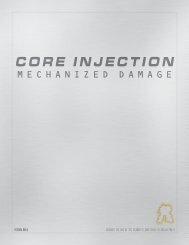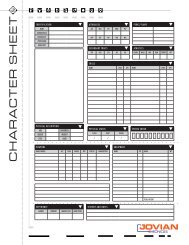renegadelegionneveren dingoffensive - Catsden.net
renegadelegionneveren dingoffensive - Catsden.net
renegadelegionneveren dingoffensive - Catsden.net
You also want an ePaper? Increase the reach of your titles
YUMPU automatically turns print PDFs into web optimized ePapers that Google loves.
WEAPONS<br />
Recoilless Rifles (cont)<br />
CLASS RANGE POWER MASS COST<br />
10mm<br />
25mm<br />
50mm<br />
75mm<br />
100mm<br />
5<br />
6<br />
6<br />
8<br />
10<br />
1<br />
1<br />
1<br />
1<br />
1<br />
RECOILLESS RIFLE DAMAGE READOUT<br />
2<br />
7<br />
12<br />
16<br />
23<br />
4 950<br />
12 375<br />
39 600<br />
47 000<br />
54 000<br />
10mm 25mm 50mm 75mm 100mm CLASS<br />
HEAP<br />
HIEX<br />
HESH<br />
IWF5 IWF7 IWF7 IWF9 IWF9 HEIF<br />
1 RND 1 RND 2 RNDS 2 RNDS 3 RNDS ASDR<br />
-- -- -- -- -- INCEN<br />
SSS-G Missiles<br />
SSS-G (Scanner Silhouette Seeking - Ground)<br />
missiles were developed by the same TOG design<br />
team working on the Air- to-Ground missile soon<br />
after completing the AGM project. Once they had<br />
solved the trick of getting SSS missiles to lock<br />
onto grav tanks from above, it was little stretch of<br />
the imagination for them to adapt this technology<br />
to a working surface-to-surface model. There were<br />
some key differences that were beyond their reach,<br />
however, mainly in dealing with the different nature<br />
of the respective launching systems. So, once the<br />
seeker head was completed, they handed the unit<br />
over to the Borch weapons company, to install onto a<br />
launching motor that could both handle the required<br />
operational parameters, as well as be easily fittable<br />
into grav-tank design.<br />
The result was the SSS-G, a missile pod that was<br />
roughly comparable in size to the SMLM, but quite<br />
different in its internals. As can be expected, the<br />
SSS-G functions much in its ground-based version<br />
as it does in its original incarnation. Using the tank’s<br />
normal sensors, a gunner can quickly identify and<br />
lock-in a target, and then fire as many SSS-Gs at<br />
the target as they so desire. With a longer range<br />
and no need for painting, the SSS-G has some extra<br />
capabilities over its TVLG and SMLM brethren.<br />
However, it does suffer more adversely from<br />
weather conditions, and gains no benefit if the target<br />
is indeed painted.<br />
The SSS-G has yet to be used in combat. Testing<br />
has just begun within the TOG forces with a rather<br />
lacklustre showing of interest. It is unknown at<br />
this point whether or not the SSS-G will ever see<br />
widespread use, or if it even sees use at all.<br />
Game Notes:<br />
The SSS-G is a new missile system, requiring its<br />
own special launchers. To use an SSS-G, the attacker<br />
must first lock onto the sensor signal returning from<br />
its target by making a regular attack roll. Do not<br />
modify the roll for shields, but double any weather/<br />
atmosphere/terrain modifiers for obstructions or<br />
poor visibility. If the roll is successful, the missiles<br />
have locked-on, and the tank may fire as many<br />
SSS-G missiles as it so wishes at the target. SSS-G<br />
missiles may be attacked by a Vulcan system just as<br />
any other missile can. Once fired, the player must<br />
then roll the actual SSS-G attack, using a base to-hit<br />
number of 15, modified as normal for the target’s<br />
shields. If successful, the SSS-G inflicts a 15 point<br />
hit. SSS-Gs are incapable of indirect fire. All other<br />
standard rules apply.<br />
CLASS TO HIT RANGE POWER MASS COST<br />
SSS-G 1<br />
SSS-G 2<br />
15<br />
15<br />
SSS-G DAMAGE READOUT<br />
15<br />
15<br />
SSS-G<br />
0<br />
0<br />
4<br />
8<br />
15 000<br />
30 000<br />
XLIV





